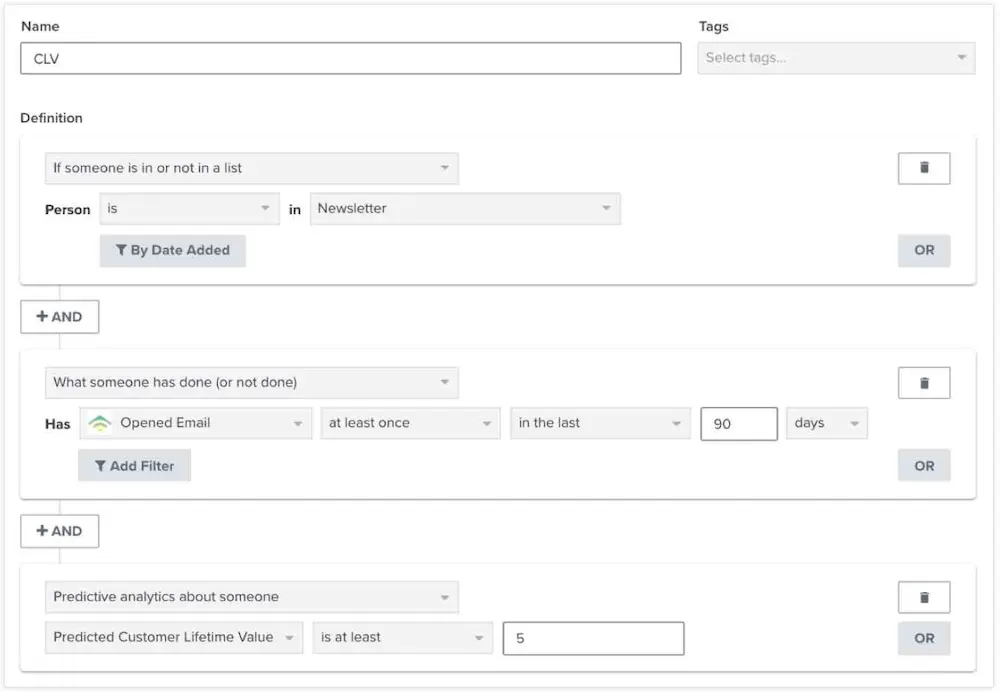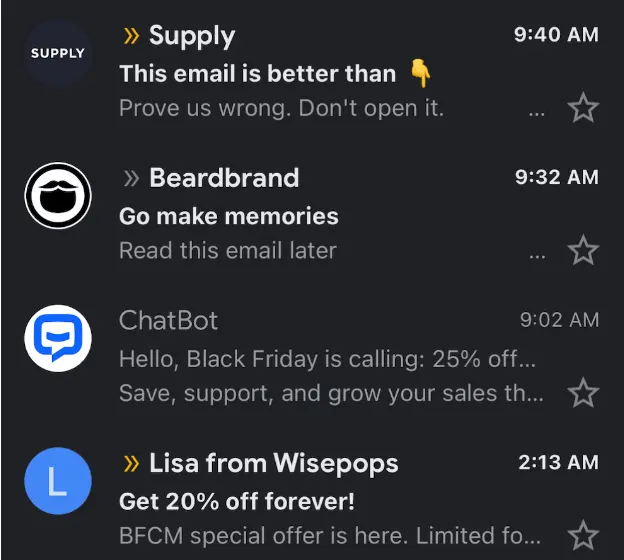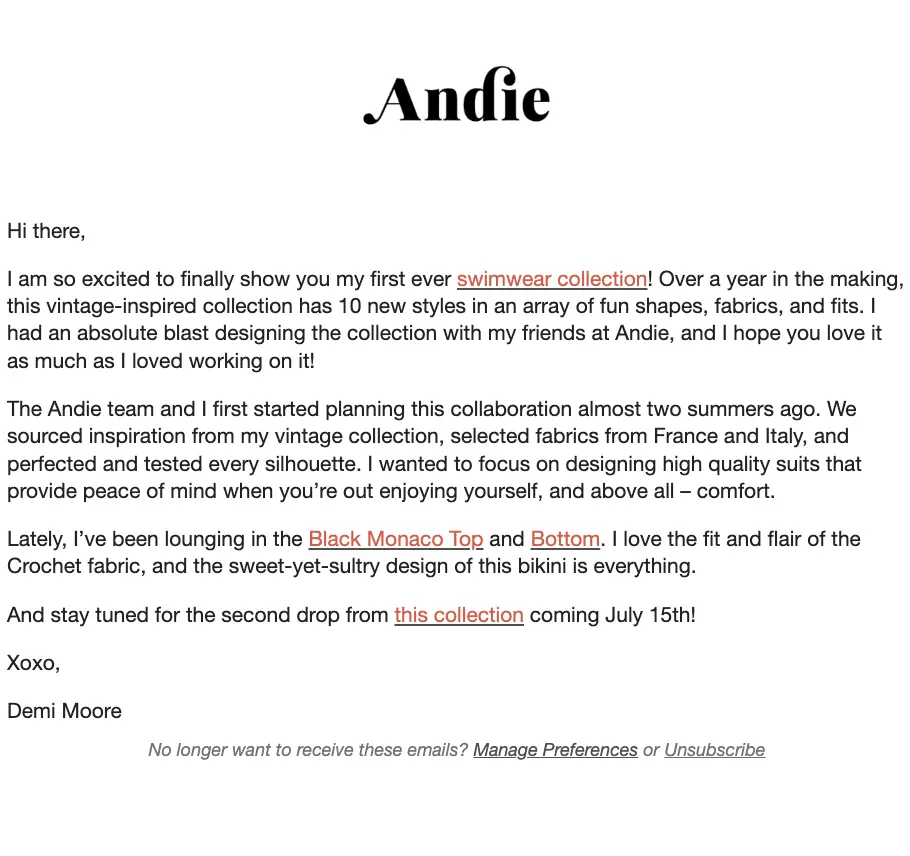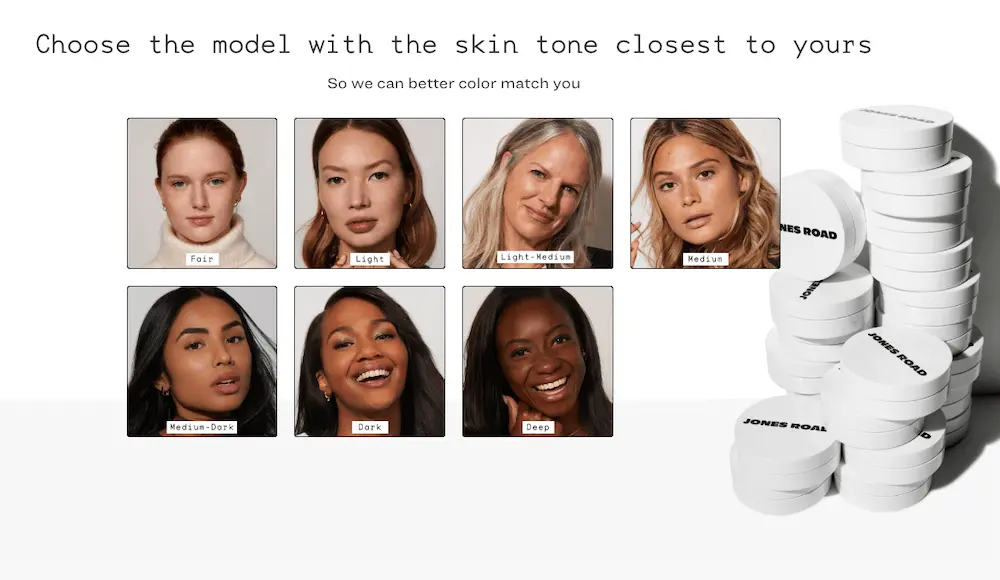From inbox to revenue: 3 brands share email marketing best practices to accelerate growth

“Sure, Fred Astaire was great, but don’t forget that Ginger Rogers did everything he did…backwards in high heels.”
This quote, often misattributed, comes from cartoonist Bob Thaves in his iconic strip Frank and Ernest.
Algorithm-dictated success can be exciting, but fleeting. And chasing it—like dancing backwards in high heels—requires a ton of time, expertise, and probably a little wobbling, at least at first.
Even if you “rehearse,” these social media algorithms can still be confusing, unfair, and hard to learn the rhythms of.
When you combine that tireless effort to keep up with a shifty, uncertain economy, you’ll likely find yourself reevaluating your dance partner—and opting for one that’s more predictable.
Enter from stage left: email marketing.
Email marketing frees you from the constraints of third-party algorithms. You have total control over what you say and when you say it. So make sure to give your audience a performance they’ll never forget.
We interviewed industry experts, drew from the data of thousands of Klaviyo users, and synthesized the most recent marketing knowledge to put together this guide to email marketing. Bookmark it to strategize for the whole year.
The benefits of email marketing: “everything”
What’s the biggest benefit of email marketing? Andrew Benin, co-founder and CEO of olive oil brand Graza, has a succinct answer: “Everything.”
“Everything is a reward with email marketing,” he says. “It’s a chance to express your brand, send updates to an engaged community, and let people manage their subscription fairly and transparently. And these are all ways to stay relevant that are highly economical.”
And the numbers prove it. Based on data from over 100K paying customers, Klaviyo’s email marketing metrics show what’s possible engagement- and revenue-wise for brands that use this channel:
- Click rates for all flows are nearly 6%.
- Revenue per recipient for all flows is $1.73, but significantly higher for welcome email flows ($2.13) and abandoned cart flows ($3.53).
- Conversion rates are nearly 4% for abandoned cart flows.
That’s not to say email marketing is necessarily simple. There are plenty of challenges, including figuring out:
- How to stand out in a crowded inbox
- How to balance your communications and stay relevant to subscribers without annoying them
- A content strategy for campaigns and flows
- How to time your emails
- Deliverability
But don’t worry. We’ve got tips and detailed guidance to walk you through each of these challenges—and more.
Own your growth—but first, grow your list
Email marketing can’t be effective if you don’t have an engaged audience to send to. So, how do you build—and grow—your email list?
There are several ways:
Forms on your website
A sign-up form on your website is a common and straightforward way to collect email addresses.
Here are some takeaways from data Klaviyo gathered from over 80K Klaviyo customers:
- Pop-up forms tend to convert at a higher rate (3.2%) than fly-out forms (2.2%).
- Most forms (85%) have 2 fields or fewer.
- Forms have higher submission rates on mobile (3.2%) than on desktop (2.3%).
- Sign-up forms with discounts have 90% higher subscription rates.
Embedded forms live on your website and are static. Skincare brand KORA Organics has this embedded form at the bottom of their homepage. It’s out of the way and not intrusive.

A pop-up form appears on your site once an action (or amount of time) triggers it.
You can use criteria like this to determine when your pop-up appears:
- How long a visitor has been on your site (usually 10-25 seconds)
- Whether the visitor hovers over the address bar in the browser, signaling an intent to leave your site
- How many pages the visitor clicks through
Herbal sparkling water brand Aura Bora uses the Klaviyo form builder to set up a first-user cookie on their site that identifies a user who hasn’t visited before. After thorough testing around the timing of the pop-up, they set it up to appear after a user has been on the site for 10 seconds.

You can also use forms to collect a shopper’s birthday, communication preferences, and other demographic information, so that later on you can send them a birthday month discount or exclusive promotions.
At check-out
If you’re collecting a shopper’s email address at check-out to send them shipping information, you can add an opt-in that asks if they want to receive promotions and marketing messages.
Brand partnerships
If you have a relationship with a brand that is better known than yours and sells products or services that are complementary to your own, consider a partnership that might benefit both parties.
You might create a social media giveaway together, encouraging one brand’s audience to join the other’s email list, with an incentive.
Or, you might develop a co-branded email subscription for your partner’s website, or even a limited-edition co-branded product, like the great minds at Parachute and OSEA did.

One way to collect emails for a project like this is to encourage an email sign-up for VIP access.
Learn more tips and strategies on how to grow your email list.
Segmentation: what it takes to ensure your audience gets the most relevant messaging
Once your list is big enough to see results with email marketing, segmentation becomes your next top priority.
What is email segmentation?
It’s a process that divides your subscriber email lists into smaller portions based on customer interests and behavior.
For instance, you shouldn’t send folks who have never bought anything from you and only open 1 out of every 5 emails the same messaging you send to people who engage with your messages or purchase every time you have a promotion.
Segment them into different lists so you can make the messaging more personal to where each person is in the customer journey.
Why should you segment?
Your customers may be of different ages, in different locations and climates, with varying budgets, interests, needs, and social backgrounds.
Sending them different emails can help you meet them where they are: introducing them to your brand if they’re new to your list, for instance. Showing them those new wool socks around the first frost, or promoting that bathing suit sale when spring hits their state.
But there are other benefits to segmenting as well.
Segmenting means you send less generic marketing emails, helping protect you from spamming your subscribers. This is important because once customers start marking your emails as spam, your sender reputation can drop, affecting your deliverability. With fewer spam complaints, segmentation helps you earn higher open and click rates and lower unsubscribe rates.
Paw.com saw a 145x monthly average ROI using email segmentation in Klaviyo, and apparel brand Taylor Stitch saw a 60% increase in revenue per recipient, as well as a 60% decrease in unsubscribes, by segmenting their contacts in Klaviyo.
4 steps to segmenting
Your carrier should help you automate list management so that creating segments doesn’t take too much work.
1. Determine your criteria for segmenting

You can make as many or as few as you like. Some valuable segments usually include:
- Product-specific audiences
- Full-price buyers
- Customers who only shop with coupons
- Shoppers who only buy on certain days
- Unengaged customers
- Shoppers who’ve viewed the same product 5+ times without buying
- VIP customers (frequent shoppers or big spenders)
2. Collect customer data
In order to categorize subscribers into segments, you need to know who they are. The best and safest way to do this is to collect data directly from them. Klaviyo empowers you to collect Customer-First Data™ from your first interactions.
3. Set up your email segments and start sending
Make sure you’re monitoring for performance indicators like:
- Open rate
- Click rate
- Spam complaint rate
- Conversion rate
As you see which segments are doing well and which aren’t, consider A/B testing to optimize the performance of your emails.
4. Make adjustments as needed
Your segments will likely change frequently as you clean your lists and subscribers move from regular customers to VIPs, etc. So, don’t just set it and forget it. Keep a close eye on them.
Jewelry and apparel brand Sivana sends this email to people who have subscribed to their emails but haven’t bought anything yet. It includes a discount code, links to their most popular collections, and a countdown clock to inspire a sense of urgency.

Cameron Faist, director of ecommerce at herbal sparkling water brand Aura Bora, shares that the brand has a huge number of active segments, but the most engaged segments add up to about a dozen.
Aura Bora collects zero-party data from post-purchase surveys, including geography, household income, whether they’ve bought on the website or Amazon, or at their retailer of choice. Based on what shoppers share with them in the surveys, Faist says the brand sends geo-targeted messaging.
For example, the herbal sparkling water recently launched in Publix, a major southeast retailer, in February 2023. Aura Bora sent out segmented messaging to their subscribers in that region soon after—making sure not to send it to people in states far away from the launch.
Faist also highlights the importance of discipline in segmentation. “I think the most important thing is really customizing your creative and your messaging to a specific audience, and not being afraid to only send campaigns to a quarter of your list, or half,” he says.
“Your open rates and ultimately your revenue will be impacted by that. The headline is: Don’t be afraid to segment.”
Subject lines that stop them in their tracks
Once you’ve grown your list, you need to make sure your subscribers are actually opening your emails.
It’s not easy. Inboxes are getting more and more crowded, and no brand wants to end up in the dreaded “promotions” tab.
That’s why your subject lines are so crucial to your email marketing strategy.
Klaviyo’s business intelligence team recently studied over 600K email campaigns sent in 2022 to understand what kinds of subject lines perform best.
Here are 6 tips for getting your readers’ attention:
1. Personalize your email subject lines
Use the reader’s first name, and consider personalizing the content of the subject line based on Customer-First Data such as recently viewed products, items ordered, abandoned products, or most-viewed products.
Bridal brand Kennedy Blue, for example, uses the subscriber’s first name in the preview text, making the communication feel more personal.

Check out some of the best examples of email subject lines to inspire your next outreach campaign.
2. Keep your subject lines short
According to our research, as subject lines get longer, subscribers are less likely to open the email. Try to keep them around 7 words long (including emojis), and less than 36 characters.
Skincare brand Drunk Elephant keeps this subject line to 4 words plus an emoji: short and to the point.

3. Consider communicating FOMO—and urgency—in your subject lines
It’s a competitive world out there, and in your subscribers’ inboxes, too. A reminder that offers don’t last forever may push your readers to open the email.
Here, clothing brand Faherty leads with the urgency of their subject line.

4. Consider the context for every subject line
What’s your email up against, competition-wise? If it’s BFCM, that’s a very different scenario than a random promotion on a Tuesday in April.
Personal grooming brand Supply rose to the occasion around BFCM, making good use of an emoji.

5. If you’re including a discount in the email, make sure it’s in the subject line
Here, clothing brand Favorite Daughter leads with a (huge) discount, and it’s a smart move.

6. Use the preview text
Clothing and jewelry brand Sivana uses the preview text to tease a discount. While that information may not have fit in the subject line itself, it’s a great way to make sure the reader sees it before they move on to the next email.
Preview text tip: If you don’t include it, the first sentence of your email copy will automatically show up. This is a waste of an opportunity to drive engagement—and can make your subject line appear confusing or disjointed with the text that follows it.

The science behind crafting engaging emails that convert
When thinking through how to put your emails together, there are big picture questions and practical ones.
Let’s look at some bigger picture questions first:
- What are you actually saying?
- What’s the occasion for this communication?
- Is it a promotion or sale?
- Is it to thank subscribers for participating in a larger cause?
- Is it to share content you think they’ll like?
- Is it to celebrate a milestone?
- How do you want your subscribers to feel upon reading it?
Some more practical questions to consider:
- What action do you want the reader to take upon reading the email?
- What time of day are they likely to open it?
- What energy level are they likely to be at when they open it?
- Is there an urgency to the email you’re sending?
Getting clear on your goals for every message can help determine the copy and design decisions you make to build the actual campaign or flow.
Layout, design, and CTAs
Typical marketing emails include a professional logo, a navigation bar, images, the actual message, and a call to action (CTA).
The email below, from beauty brand Wildling, features their logo at the top and a navigation bar directly below, and forefronts images of the product against a background that reinforces their brand identity. The salmon and rose colors are soothing—appropriate for a beauty ritual brand.
The copy is concise, friendly, and gets right to the point: a 10% discount and the code the reader needs to take advantage of it.
This email also includes a countdown clock, a tool that’s good at conveying urgency while making it clear to readers exactly how much time they have left.
It also includes links to their rewards program, their reviews page, and social pages. And the option to unsubscribe is also clearly marked at the bottom.

Nicole Briganti, CRM senior manager at Andie Swim, says the design strategy of an email should depend on the campaign.
“We try not to overwhelm the shopper,” she says. “If there’s a new collection, that’s when we’ll feature an array of different styles. But since Andie is all about fit, we try to balance that with specific style highlights and close-up images of the suits.”
The Andie Swim email below features a new collection, with 5 different styles, each with its own dedicated CTA button.

This one, on the other hand, highlights “the perfect swimsuit” and provides close-ups that show it off. Because it’s all the same product, there are fewer CTAs.

You may notice that the CTA button is down pretty low in Wildling example and specific to the goal of the email with Andie Swim’s examples.
While it’s standard practice to include one CTA button above the fold and another below, the amount and placement of CTAs in an email really depends on the goal of the communication.
Keep their attention (+ win their trust) with your brand’s authenticity
Facing a looming recession and a bear market, premium brands like Aura Bora had tough decisions to make.
Where to invest limited marketing dollars? Do they focus on acquisition or retention?
Faist shares that Aura Bora cut all performance marketing and reduced their acquisition budget to zero. As a sparkling water brand, they typically do 80% of their revenue between Memorial Day and Labor Day.
So, the decision to focus exclusively on owned channels—which cost nothing beyond platform fees—sprung from a strategy to rely on their existing customer base to drive revenue in the off-season, Q1 and Q2 of 2023.
Key to this strategy is distinguishing between brand-focused and product-focused email campaigns. Faist considers a brand-focused approach to include no price promotion or discounts. Instead, they focus on evergreen content and some “absolutely unhinged, fun creative.”
The results?
“The open rates and revenue per user are just incredible,” Faist says. “70% of our online revenue for our own Shopify store has been driven through Klaviyo in the last 60 days since we’ve made that decision to cut off all performance marketing.”
Check out these fun, brand-focused emails from Aura Bora for inspiration.
The first one features a kooky character and beautiful imagery. The second one goes against best practices and takes big risks, which could feel so out of the ordinary that it may really stand out in the inbox. Both are fresh, creative ways to build community and express the brand’s personality.


Andrew Benin at Graza, shares the artistic standard for design in their marketing emails.
“We want our emails to be visually alluring, treating them as if they were a music festival poster that you want people to get to the bottom of. And we maximize the amount of imagery that Klaviyo can maintain, the amount of gifs, the amount of space that we can utilize on pretty much every single campaign that we send,” he says.
Graza’s email below uses bold colors and fonts, a saucy perspective (pun intended), and original imagery.

Another way to express your brand’s personality through email is to strip it down. Some messaging works best with fancy fonts, intricate designs, and off-the-wall copy. But others work best on their own, without any bells and whistles.
Briganti at Andie Swim shares that “if we do a really exciting launch or we’re expanding into a new category, we’ve been playing around with the idea of letters from our CEO or fit experts.We typically see stellar click rates and responses from those emails. Sometimes a simple plain text email is the perfect way to convey our message.”
See an example below from a partnership with Demi Moore.

Some final tips for putting your best foot forward for creative, effective email design:
- Invest in your creative team. Writers and designers need time and resources to ideate, create, iterate, and perfect.
- Follow best practices for email design —unless you’re ready to take a risk.
- When taking risks, go big or…well, you don’t have to go home, but you should A/B test. Like Aura Bora, your risks may pay off. But if they don’t, you’ve still learned a valuable lesson about the state of your relationship with your customers.
- Trust your instincts. Your team knows your brand better than anyone.
Personalizing content
There isn’t exactly a silver bullet to email marketing, but if there was, it may be personalized content.
According to McKinsey, brands that do personalization well generate as much as 40% more revenue than those that don’t—and nearly 75% of consumers expect personalization in their interactions with brands.
When you’re collecting email addresses and phone numbers in your forms, consider asking shoppers for 1-2 of the following pieces of information as well:
- Their birthday
- What products they’re interested in
- Why they’re shopping
- How often they want to purchase your products
- What kinds of emails they want to get
Consider how someone who’s expecting might want marketing messages about diapers and baby clothing, while someone who has suffered a miscarriage would likely want to skip those types of messages.
Baby, beauty, and homecare brand Honest shows website visitors this email pop-up form right away. In addition to offering the visitor 20% everything to become a subscriber, the brand provides options for messaging. This has the potential to create a relationship that’s even more consensual and enthusiastic.

You can collect this information in a multi-step form or a quiz on your site. Jones Road Beauty, for example, offers this quiz on their website. It guides visitors to learn more about the best color matches for their skin tone.

The brand can then send customers emails like this one, featuring the products that make the most sense for them.

Timing is everything: optimize your send times
Once you’ve collected the data you need, created your segments, and built beautiful, personalized emails, there are still a few more hurdles to jump.
When you send emails matters. A lot. First of all, inboxes are full. And competition is fierce: Your marketing email may be right above one from someone’s mom, or their boss.
The good news is that you can learn the days and times your audience is most likely to open your emails. The better news is that you can use machine learning as a shortcut.
While open, click, and conversion rates vary throughout the year and even throughout the week, they usually depend on who your audience is and where they live. That’s another reason why segmentation is so important.
Align your flows to the customer journey
Thriving brands tend to automate flows according to the customer journey, such as:
- Win-back
- Browse abandonment
- Abandoned cart
- Welcome series
Automating a flow according to the customer journey means it doesn’t go out at, say, 9 a.m. on a Tuesday, but rather at a time relative to the customer’s behavior.
For example, if you sell coffee beans and the buyer usually purchases every 2 weeks, you may trigger a win-back automation to send a month after someone’s last purchase. If you sell phone cases, on the other hand, a win-back automation might not make sense to send until a customer has been inactive for several months.
Think through your products and the cadence with which customers usually buy them, and plan your automations accordingly.
Test your campaign send times
When sending email marketing campaigns, first remember that best practices place campaign frequency around 2-5 messages a month. To determine the best send time for those few, think through:
- Relevant information about your customers
- Anything relevant about the product(s) you’re featuring
- Context about time of day, season, where your subscribers (or segments) are located, etc.
Once you’ve sent a few campaigns at the times you think are best, track your results.
Klaviyo’s Smart Send Time feature can help you find the best time to send your campaigns by sending exploratory sends, sharing the results of those send times, and continually refining send times.
Last but not least: deliverability
Another aspect of email marketing that is often overlooked is maintaining your sender reputation. If you don’t, your deliverability can take a hit.
Clean your lists
If you send too many emails to customers who aren’t opening or clicking them, the carrier might flag your emails as spam. That’s why it’s important to clean your email lists and to send primarily to your most engaged customers.
Aura Bora’s strategy to keep their sender reputation high requires quite a bit of discipline. “We are very particular in our list cleaning and who we send to and when,” Faist says. “We very, very rarely send to ‘master all’—maybe around Black Friday and Cyber Monday, or a big site-wide promotion.” (“Master all” means their entire list.)
For most campaigns, Faist says, they look at the 180 days previous to the send. Aura Bora takes into consideration engagement and conversion, as seen through a segment they created in Klaviyo. This ensures they’re only sending to their most active users.
“That then informs deliverability to all carriers,” Faist says. The tactic helps keep them out of Gmail’s promotions tab and off Apple’s blocked list.
Only sending to those most active users means they don’t send to about 25K users. While that may sound like a missed opportunity, Faist says “the numbers speak for themselves.”
If you use Klaviyo as your carrier, your segments update dynamically and you’ll have clear visibility into your unengaged segments. You can send them win-back campaigns, and, if they don’t respond, remove them from your list.
You should remove all unengaged customers at least once a month.

Make it easy to unsubscribe
This may sound counterintuitive, but it’s important that your subscribers feel free to leave. If the “unsubscribe” button is difficult to find, they may hit the “spam” button instead, hurting your sender reputation.

More deliverability best practices
Some other deliverability best practices include:
- Avoid using spam trigger words, especially in the subject line.
- Design your emails with your brand colors so they’re recognizable.
- Consider asking questions in your emails so that your subscribers can respond.
Inform your subscribers about how to whitelist your emails.
Take control of this year
While there’s no set of best practices that fits every brand, we hope this guide sets you up to make the most out of your little corner of the internet: your email list.
It’s an uncertain economy, but you don’t need to flee the stage in the coming months. Just the opposite—you need to liven up how you show up for your customers on your owned channels.
If you’re looking to maximize your marketing efforts, your email channel is the best place to start.

Related content

Even though the BFCM season ended, there are still important precautions to take. Learn how to clean up your sender reputation at the beginning of December.

Boost your holiday sales with 6 Christmas email marketing ideas and real examples to help your brand stand out, engage shoppers, and drive revenue.

Gmail’s new updates are here: see what changed, why it matters, and how marketers can adapt ahead of BFCM.